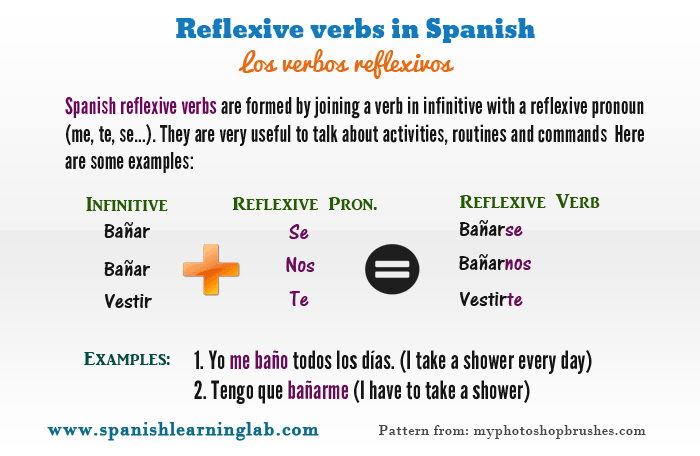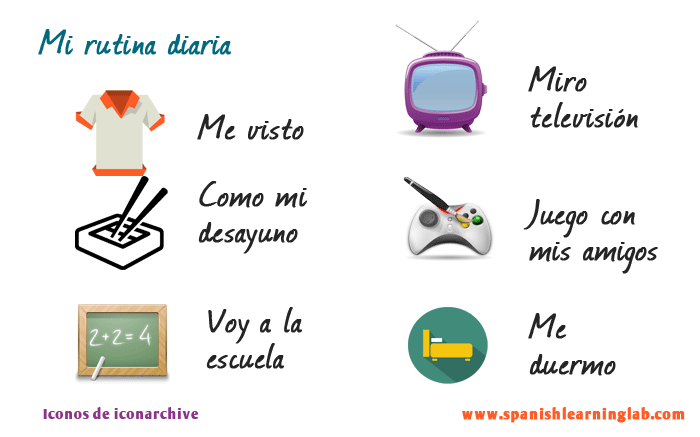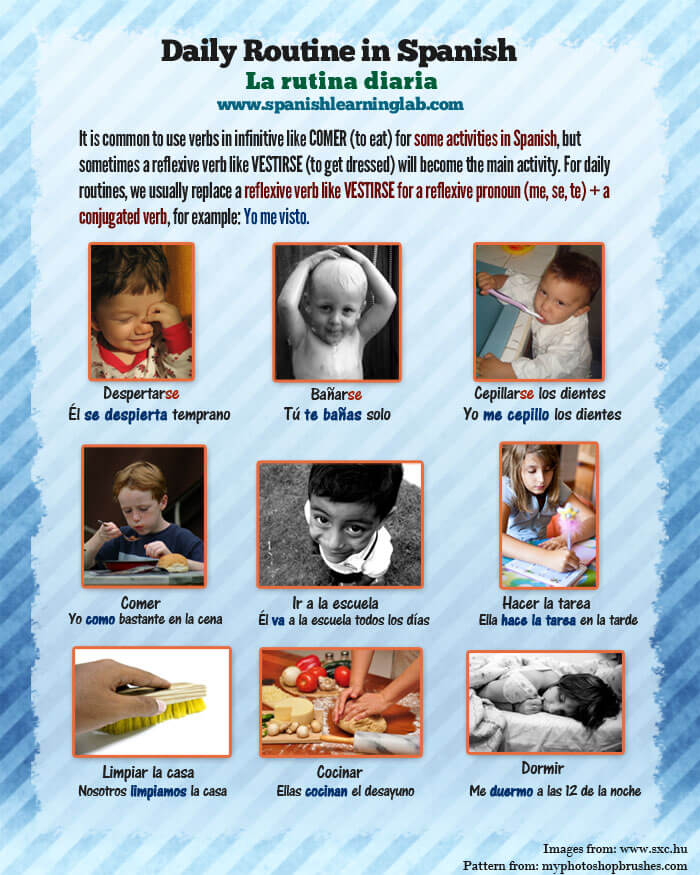Describing Items Using Reflexive Verbs in Spanish
Ir - to go. In Spanish we also use reflexive verbs when talking about our or someone elses daily routines.

Reflexive Pronouns And Verbs In Spanish Rules And Examples Youtube
When verbs end in se theyre reflexive.

. First we will see a list of daily routine activities in Spanish that are represented by reflexive verbs. Reflexive pronouns use the same forms as indirect object pronouns with the exception of se which is used instead of for the third person. For example if youre doing something to yourself like brushing your own hair then youre most likely going to be using the reflexive to describe that in Spanish.
The Ultimate How-to Guide for Using Spanish Reflexive Verbs. Reflexive Pronouns in Use. Most books give the students reflexive verbs they can use to describe a daily routine.
Dormir - to sleep. In English we sometimes use the word commit in front of reflexive verbs such as to perjure commit perjury meaning to lie under oath which can only be done by the person in. Do you know youve been using reflexive verbs since day one of your Spanish journeyYoull learn all about reflexive verbs in Spanish in this Spanish grammar.
Despertarse wake yourself up levantarse getstand up ponerse put on as in clothing and so on. The infinitive form of a reflexivequasireflexive verb is written with the reflexive pronoun se. Afeitar - Afeitarse To shave to shave oneself.
Basically a reflexive verb like LEVANTARSE to get up will change to SE LEVANTA or ME LEVANTO. Students will review the uses of verbs correct conjugations and apply their knowledge into a project. To describe your daily routine in Spanish you must use the present tense of verbs such as comer ir hacer volver and some reflexive verbs like levantarse.
Describing daily routines in Spanish. Conocerse to know each other. In the sentences below the subject performs the action on itself and the subject and object of the verb refer to the same entity.
Examples and common verbs Spanish reflexive verbs in daily routines Most activities in daily routines are verbs in infinitive like JUGAR to play or COMER to eat and sometimes Spanish reflexive verbs such. When the action remains in the verb itself and it uses a reflexive pronouns we call it quasireflexive verbs. A list of daily activities in Spanish using reflexive verbs.
Lavar - Lavarse To wash to wash oneself. Think of reflexive like reflectionsthis is the verb type we use when the agent of the action is acting on his or her own self. Click here to listen.
Notice how the verb adds a se at the end to make it reflexive. Ir se - to leave to go away. There are several types of reflexive verbs in Spanish.
One is a woman brushing her teeth the second is a man combing his hair the third is a woman putting on mascara and the last one is a. Poner se - to put on clothes Watch in introductory powerpoint explaining how reflexive verbs work. As a general rule reflexive verbs are used when describing an action that you perform and that is going to.
Lavarse - to wash oneself bañarse - to shower peinarse - to comb ones hair. If you watched the video then this part will be easier to understand. Introduction to Reflexive Verbs in Spanish.
Horrizarse to be horrified. Emocionarse to be excited. Spanish verb group Spanish reflexive verb English translation.
To be bored get bored. Spanish also has verbs that are considered inherently reflexive not the same ones as English and some that can become reflexive in certain scenarios. Me myself te yourself se yourself formal himself.
Alegrarse to be happy. For example quedar can mean to. Casar to marry.
However for many people it is difficult to know when you need to use these verbs. There are 4 pictures. To believe to believe oneself.
Estás lavándo te los dientes. Both sentences mean I want to take a shower. Using Reflexive Verbs to Describe your Activities.
Using Tener With Emotions. Te estás lavando los dientes. Reflexive verbs are also sometimes used to describe an emotional response.
What Are The 5 Reflexive Pronouns In Spanish. Many actions related to personal care or daily routines are reflexive but other verbs can be reflexive as well. Unlike the standard verbs reflexive verbs are used to express that a person does and receives an action to themself.
Conocer to know. Now lets take a look at how you conjugate reflexive verbs in the present tense by. Poner - to put.
Reflexive verbs in Spanish are a challenge because their meaning can be quite different from their normal verb form. Reflexive verb conjugated complement. And sorprenderse to be surprised Erichsen Gerald.
Dormir se - to fall asleep. Although estar can be used with some emotions Spanish speakers often prefer to use tener the verb for to have in the sense of to possess with some emotionsIn effect the idiom is that a person has a particular emotion rather than that the person is in a certain emotional state. The English equivalent of this is becoming something eg I became sad or something making you feel a certain way eg I get bored or it makes me happy.
Dolerse to be hurt. Lets take a look at a few common reflexive verbs starting with the two most common ones you will need to speak basic Spanish. This lesson provides an overview of Spanish reflexive verb uses and conjugations.
The second verb a reflexive verb in Infinitive or Gerundio. Among the many verbs used the way are aburrirse to be bored. To buy something for oneself.
We have the freedom to place the reflexive pronoun either before the first verb or attached at the end of the reflexive verb. Reflexive verbs as daily activities in Spanish. For example although you could say está asustada to.
Those which also have a non-reflexive form with a similar meaning such as. Reflexive verbs are quite common in any Spanish conversation. As a result reflexive verbs may be one of the most difficult topics to learn.
When to Use Reflexive Verbs in Spanish. Results 1 - 24 of 127 This 5 page handout and worksheet explains the use of reflexive verbs and focuses on the verbs involved in daily personal routines. Example sentences using reflexive and quasireflexive verbs.
Write sentences in Spanish using reflexive verbs to describe each of the images below.

10 Common Mistakes In Spanish Daily Routines Spanishlearninglab

Conjugating And Using Spanish Reflexive Verbs Spanishlearninglab

Sentences With Daily Routine Activities In Spanish Spanishlearninglab
Comments
Post a Comment